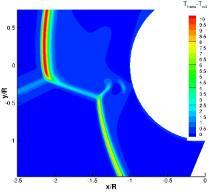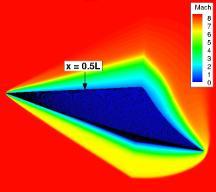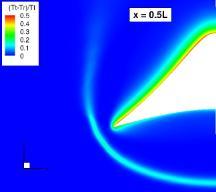Gas Dynamics
|
With the increased interest in hypersonic vehicles, there is a need for efficient and accurate prediction of the flow field, aerodynamics and heat transfer throughout their flight regime. At intermediate altitudes, the flow around an hypersonic aircraft can be characterised as mainly continuum with localised areas, generated by the rapid expansion in the wake of the vehicle as well as by strong gradients in shock waves and boundary layers, that display thermal non-equilibrium effects. At the University of Glasgow CFD Lab; Gas Kinetic Schemes, discrete-velocity methods and hybrid approaches are implemented in the Multi-Physics Code (MɸC) and constantly developed to takle high-speed flows with important rarefaction effects. |
|
|
|
|
|
When the gradients of the macroscopic variables become so steep that their scale length is of the same order as the average distance travelled by molecules between collisions, the number of impacts is not enough anymore to drive the fluid towards a local thermodynamic equilibrium. In this condition is not possible to consider the fluid as a continuum and the transport terms in the Navier-Stokes equations fail since the constitutive relation is not valid anymore.
The mathematical model at molecular level is the Boltzmann equation and the methods that are commonly employed to simulate rarefied flows are the Direct Simulation Monte Carlo (DSMC) and discrete-velocity methods for kinetic Boltzmann equations. However, these approaches require higher computational cost than continuum methods. This has motivated the development of hybrid techniques which restrict the use of the expensive non-continuum approaches to regions where significant non-equilibrium effects occur. An alternative approach is represented by Gas Kinetic Schemes, a finite-volume method where the numerical fluxes are based on the solution of the kinetic Boltzmann equations able to capture effects of moderate thermal non-equilibrium.
Contacts
Dr. S. Colonia Simone.Colonia@Glasgow.ac.uk
Dr. Rene Steijl Rene.Steijl@Glasgow.ac.uk
Publications
- Colonia S., Steijl R. and Barakos G. N., Kinetic Models and Gas Kinetic Schemes for Hybrid Simulation of Partially Rarefied Flows. AIAA Journal, 2016, Vol. 54, p. 1264-1276, DOI:10.2514/1.J054137.
- Colonia S., Steijl R. and Barakos G. N., A Gas Kinetic Scheme for Hybrid Simulation of Partially Rarefied Flows. Progress in Flight Physics Volume 8 - EUCASS book series.
- Colonia S., Steijl R. and Barakos G. N., Kinetic Models with Rotational Degrees of Freedom for Hybrid Methods. 6th European Conference on Computational Fluid Dynamics (ECFD VI), ECCOMAS 2014, 20-25 July 2014, Barcelona (Spain).
- Colonia S., Steijl R. and Barakos G. N., Kinetic Models and Gas Kinetic Schemes for Hybrid Simulation of Partially Rareied Flows. AIAA Atmospheric Flight Mechanics Conference 2015, 5-9 January 2015, Kissimmee (Florida).
- Colonia S., Steijl R. and Barakos G. N., Gas Kinetic Schemes for Hybrid Simulation of Partially Rarefied Flows. 6th European Conference for Aeronautics and Space Sciences, 29 June to 3 July 2015, Krakow (Poland).
- Colonia S., Steijl R. and Barakos G. N., Shocks Interactions in Continuum and Rarefied Conditions Employing a Novel Gas-Kinetic Scheme. 22nd International Shock Interaction Symposium, 4-8 July 2016, Glasgow (Scotland, UK).





